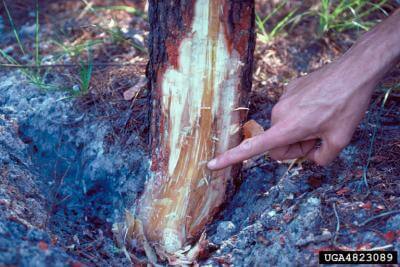
The American chestnut (Castanea dentata) and the related Allegheny and Ozark chinkapins (which are both varieties of Castanea pumila) probably began declining approximately 200 years ago with the introduction of the soil-borne algal fungus, Phytophthora cinnamomi. Throughout the 1800s, the disease gradually killed chestnut and chinkapin populations on relatively wet sites (Crandall et al., 1945).
The Phytophthora cinnamomi pathogen is widespread in soils south of 40o North Latitude (just north of the Maryland-Pennsylvania line). Several studies indicate that up to 80% of seedlings are killed. Scientists expect this pathogen to move north in response to the warming climate; indeed, some project that the root disease could reach throughout the entire current chestnut range by 2080. Warmer and wetter climates are expected to exacerbate the pathogen’s impact. On the other hand, The American Chestnut Foundation (TACF) has found some resistance to Phytophthora root rot in families providing blight resistance. TACF now plans to cross individuals from those families with transgenic blight-resistant chestnut to combine both resistances (Gustafson et al. 2022).
Gustafson et al. (2022) describe actions to minimize the risk from the pathogen in pursuing the goal of restoring American chestnut. These include breeding of resistance, careful selection soils in restoration sites, and nursery hygiene measures.
Episodes of oak decline have sometimes been blamed on P. cinnamomi but this has not been investigated conclusively. While several other Phytophthora species are also pathogenic to oaks, their scattered distributions lead scientist to conclude that they play a minor role in oak decline. P. cinnamomi mainly infects the root system (canker development on stems is limited by cold winter temperatures). Several recent studies have confirmed that fine root losses – consistent with P. cinnamomi infection – are driving oak decline events in moist low-elevation stands where inoculum levels of P. cinnamomi are higher. In colder areas – e.g., plant hardiness zones 6 and 7 – fine root regeneration is limited due to climatic constraints (See Jung et al. 2018).
P. cinnamomi is most famous for causing severe mortality in jarrah and other forests of Western Australia. Also causing widespread declines in oak forests of Europe. See Jung et al. 2018.
USFS scientists and managers developed a conservation priority-setting framework for forest tree species at risk from pest & pathogens and other threats. The Project CAPTURE (Conservation Assessment and Prioritization of Forest Trees Under Risk of Extirpation) uses FIA data and expert opinion to group tree species under threat by non-native pests into vulnerability classes and specify appropriate management and conservation strategies. The scientists prioritized 419 tree species native to the North American continent. The analysis identified 15 taxonomic groups requiring the most immediate conservation intervention because of the tree species’ exposure to an extrinsic threat, their sensitivity to the threat, and their ability to adapt to it. Each of these 15 most vulnerable species, and several additional species, should be the focus of both a comprehensive gene conservation program and a genetic resistance screening and development effort. Phytophthora root rot is not known to be a threat to any of these 15 most vulnerable species.
Sources
Crandall, R. S., G. F. Gravatt, and M. M. Ryan. 1945. Root disease of Castanea species and some coniferous and broadleaf nursery stocks caused by Phytophthora cinnamomi. Phytopath. 35: 162-180.
Gustafson, E.J., B.R. Miranda, T.J. Dreaden, C.C. Pinchot, D.F. Jacobs. 2022. Beyond blight: Phytophthora root rot under climate change limits populations of reintroduced American chestnut Ecosphere. 2022;13:e3917.
Jung, T., A. Pérez-Sierra, A. Durán, M. Horta Jung, Y. Balci, B. Scanu. 2018. Canker and decline diseases caused by soil- and airborne Phytophthora species in forests and woodlands. Persoonia 40, 2018: 182–220
Potter, K.M., Escanferla, M.E., Jetton, R.M., Man, G., Crane, B.S., Prioritizing the conservation needs of US tree spp: Evaluating vulnerability to forest insect and disease threats, Global Ecology and Conservation (2019), doi: https://doi.org/10.1016/
Robin, C., F. Dupuis, and M. L. Desprezloustau. 1994. Seasonal changes in northern red oak susceptibility to Phytophthora cinnamomi. Plant Dis. 78: 369-374.
Robin, C., M. L. Desprez-Loustau, G. Capron, and C. Delaour. 1998. First record of Phytophthora cinnamomi on cork and holm oaks in France and evidence of pathogenicity. Ann. Sci. Forest. 55: 869-883.



